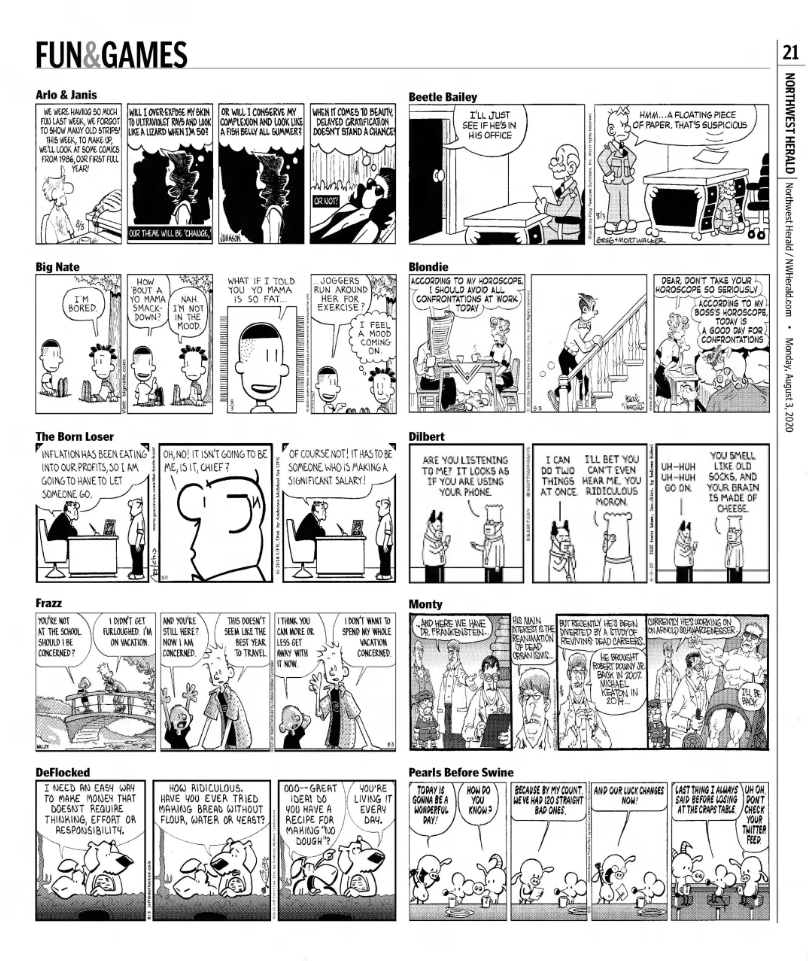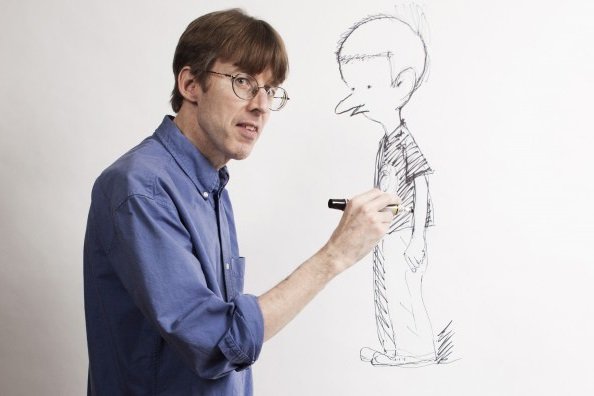
Birth of a comic
It occurred to me I never have really said why I started Railroading Stinks to begin with, this silly passion project of mine with my five readers. I have left breadcrumbs as to why scattered through-out Twitter posts and other things on this website but have never dived fully into the roots of my influences.
My early introductions to comic strips was with collections of popular newspaper comics, such as Garfield and Family Circus. Both are popular subjects of meme-mockery now; Garfield for its characters that have almost outgrown the industrialized workshop comic that spawned it and Family Circus for its ubiquitous blandness. But both series were the type of safe homogenous series a kid could find copies of easily, but never left much of a strong impression on me. While I would soon find myself reading comic books regularly thanks to Greg Farshtey’s Bionicle series for LEGO (free with each issue of the LEGO Club!), I wouldn’t pick up a comic strip series for a while more.
The Calvin and Hobbes Tenth Anniversary Book by Bill Watterson Andrews McMeel Publishing 1995
It was the inevitable Calvin and Hobbes discovery in my childhood that changed my perception on newspaper comics though. I swear every other boy I knew in late-elementary school through junior high into high school went through the same discovery of Bill Watterson’s series; but it was the Tenth Anniversary Book with its commentary that really sucked me in. Yes the main Calvin and Hobbes collections were funny, but it was that commentary on the industry of comics and the behind the scenes process that drew me in. I wanted to be a cartoonist after reading Watterson’s commentary, the way he combined artistic vision and integrity telling the story he wanted to tell; corporate interests be damned. Watterson’s strip went out on his own terms in a blaze of glory, and even years after its cancellation had an appeal that made me and others flock to it in school libraries to read.
Northwest Herald August 3, 2020 comics page sourced fromThe Daily Cartoonist
Around this time my family got a subscription to one of the big local daily newspapers, and I rushed to the comics page to read strips. Unfortunately to my disappointment, much of the same industry pressures and limitations that Watterson griped about in his commentary in the Tenth Anniversary Book were still prevalent, if not worsening thanks to the pressure from digital entertainment that was coming down on newspapers. Reading the newspaper funnies these days is how it would have felt to have watched the dinosaurs try and survive after the asteroid hit, it is often a trip through strips that should have died long ago holding on through editorial and corporate momentum. Adventure comics or long serialized stories were indecipherable to a new reader. Sure Doonesbury was long praised by comics fans but how would it make sense with its extensive character cast to a pre-teen picking it up in the post 9-11 world long divorced from the strips Vietnam roots? How the hell was something as ancient as Blondie or Little Orphan Annie still being printed? Even some of what was once seen as revolutionary like Dilbert’s workplace satire had stagnated by the point I saw it firsthand in newspapers (although fortunately when I saw it was at least before Scott Adams began his descent into political nonsense). It was a comic strip world that was increasingly bleak as the newspapers that hosted them were dying off and rather than seek innovation, newspaper comics chose stagnation. But there was something that appealed to me, about the limitations of the format and the black & white strips.
A funny thing I found a few months ago that shows just how ancient some of the newspaper comics are, with Blondie’s Dagwood staring in this 1949 special Learn How Dagwood Splits the Atom! The foreword is by General Leslie Groves, the person Matt Damon depicted in Oppenheimer. Image sourced from the Museum of Radiation and Radioactivity.
There was a silver lining though of note in the comics page which became where I rushed to read the daily strip, Richard Thompson’s Cul de Sac. Funny, wildly drawn and inventive it was enough for the ever introverted Watterson to come out of exile to sing its praises. It was an honest to God piece of comic strip creativity that felt like an ode to the potential of the newspaper comic against the dying headwinds of the genre. Those familiar with the strip know it met a tragic early end as its creator was diagnosed with Parkinson’s Disease. After eight years the strip came to an end in 2012 with Thompson passing away from the disease in 2016. While the funny pages have some honorable stand-outs, the end of Cul de Sac and Thompson’s passing for me personally feels like the passing of the newspaper comic itself. The future was in webcomics and published graphic novels/books.
Richard Thompson photo from a 2016 obituary
My prognosis of the future of the funny pages dissuaded any ideas of becoming a professional cartoonist, and I made the choice to go into college for engineering. Drawing cartoon figures was instead a recreational activity that has followed me through most of my college career, doodling idly in notebooks; silly cartoon figures that offered distractions from the drudgery of Fourier Transforms and Navier Stokes Equations. I will gladly admit I am not the best cartoonist out there and while it is something I hope to hone now and in my post-graduate career, I know of lots of better professional illustrators than myself in the webcomic world.
Animaniacs episode 30 “Moon Over Minerva” 1993
College though was a chance to re-discover my love of animated films and series; and my first year of college was spent buying up the box sets of Animaniacs a series I had grown up watching as a kid. While I loved the Warner siblings and the adventures of Pinky & the Brain, I’d be lying if I said that it was those characters that pushed me to revisit the series. It was the discovery of mentions of the controversial Minerva Mink in TV Tropes articles that really pushed the decision to purchase the box sets, and arguably the moment I stumbled into the orbit of the furry fandom. It would be something I would push back for years against, with the strong stereotypes of furries in pop culture dominating my ideas. “Sure I think the mink is hot, but okay that’s not weird right? I’m not a furry because of that right?” Yeah bud, let’s see if that argument lasts.
With that said, Minerva’s two segments are kind of… so-so. None of the Animaniacs supporting cast really got their feet on the ground in just two segments and Minerva was cut short obviously by nervous show-runners not quite ready for the nascent internet of 1993 to do what it was going to do with such a character. Her entire premise of a stuck-up but sex-crazed character in the vein of a gender swapped Tex Avery wolf never was a good fit for what was a children’s cartoon. There was potential for the story and character, but it was in the wrong place at the wrong time with the oversight of stringent rules for network children’s programming hovering over Minerva Mink’s potential. Fellow Paul Dini created character Harley Quinn (did you know Harley and Minerva share the same creator? Well now you do.) managed to grow beyond her family-friendly animation roots and star in everything from the Suicide Squad films to an adult animated series, but Minerva was and is still stuck in a sort of animation ghetto were other than a few quick cameos in the Animaniacs reboot none of the suits seem to dare touch that character again.
The Suicide Squad 2021… there is some alternate universe out there where James Gunn made an Animaniacs movie with Margot Robbie voicing Minerva Mink in 2021 isn’t there?
Also during my college years is when Marvel Comics gave a shot on a new series with a D-List superhero again (and a character who is very furry adjacent as well) with Ryan North’s The Unbeatable Squirrel Girl. Superhero-fandom was at peak tilt at this point, and Squirrel Girl was funny, irreverent and smartly written. North’s computer programming background was front and center and the comic was as much as spoof of Marvel’s own super hero history as it was an ode to STEM. I am sure I got a few concerned looks from family and friends as I was explaining my love of this series with a spunky heroine who talks to rodents. It was obvious I had a bit of a crush on the titular character as well.
Paws or maws? No computer science students with fluffy tails is obviously the correct answer.
You might be able to see where this is going… an engineering student with a love for cartoons and comics; who has always sat on the outer orbit of the furry fandom who isn’t quite fully committed but also desperately trying to tell people “no the squirrel and mink think isn’t THAT weird okay?” An engineering student who is about to stumble on an old webcomic that pulls its influences from both those newspaper comics and 90’s cartoons about a skunk who is really in love with her Amiga computers…
“Wait, so its about a skunk who works in an adult film studio who then gets stabbed? That sounds really cursed. Huh, I like the art style I might as well keep reading…”
”Oh no this is actually good.”
I shouldn’t be surprised I really came to dig Sabrina Online, it was very much that “Minerva Mink but on Adult Swim” type story I had envisioned while watching Animaniacs. It was a series free from the overbearing editorial oversight of newspaper editors and syndicates that had created that stagnation in the funny pages. Yet the self-publishing thing made it an interesting expression of the author’s ideas. Nobody could tell Eric Schwartz what could and couldn’t go into Sabrina Online and there is a sense of his own self editorial work in deciding what fit Sabrina’s world and what made sense to print as stories in his adults only content. Sabrina Online is a comic that could comment on sex, violence, and other cultural taboos while somehow managing to be no more offensive than a regular Simpsons episode.







